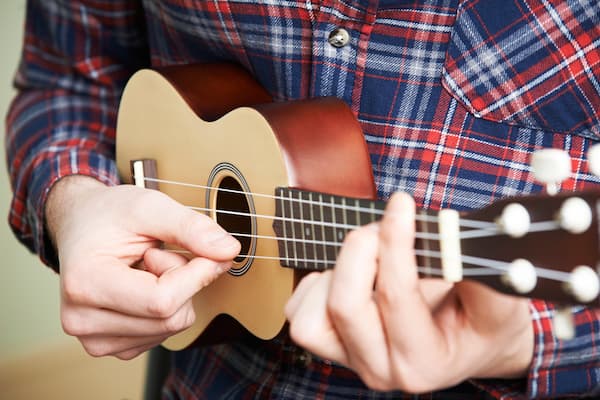The ukulele is a small four-stringed instrument that originated in Hawaii in the late 19th century. Its unique sound and versatility have gained popularity worldwide in recent years. The ukulele is relatively easy to learn and is an excellent instrument for beginners of all ages. Its small size and weight make it a convenient instrument, perfect for those who want to play music on the go. Whether you’re interested in learning how to strum some popular songs or exploring more advanced techniques, our ukulele lessons will provide the skills you need to play this fun instrument.


For a beginner, a soprano ukulele is a good choice. Soprano ukuleles are the smallest and most common type of ukulele, and they offer a bright and happy sound often associated with the instrument. They are also the most affordable type of ukulele, making them an excellent choice for those who are just starting and don’t want to invest too much money into their instrument. Another benefit of soprano ukuleles is that their smaller size makes them easier to hold and play, especially those with smaller hands. As you progress in your ukulele playing, explore other sizes, such as concert, tenor, or baritone ukuleles, which have different tonal qualities and playing characteristics.
The standard tuning for a ukulele is G-C-E-A, with the G string being the string closest to your face when holding the ukulele in playing position. This tuning is often referred to as “re-entrant” tuning because the G string is tuned an octave higher than expected based on the linear progression of the other strings. This unique tuning is one factor that gives the ukulele its distinctive sound. However, it’s important to note that other tunings are used in ukulele playing, and different genres of music may call for alternative tunings. Nevertheless, it’s recommended that a beginner stick to the standard G-C-E-A tuning until they become more familiar with the instrument.
There are four main types of ukuleles: soprano, concert, tenor, and baritone.
The soprano ukulele is the smallest and most common type, with a bright and happy sound often associated with the instrument.
The concert ukulele is slightly larger than the soprano and has a fuller sound, making it a popular choice for those who want a ukulele with a bit more volume and resonance.
The tenor ukulele is even larger and has a richer, more complex sound, making it a popular choice for professional musicians and those who want to play more complex arrangements.
Finally, the baritone ukulele is the largest of the four and has a deeper, more guitar-like sound. It’s often used by guitar players who want to play ukulele but prefer the feel and sound of a larger instrument.
It’s worth noting that there are other, less common types of ukuleles, such as the sopranino ukulele (even smaller than the soprano), the bass ukulele (which has thicker strings and a lower tuning), and the banjolele (which is a hybrid of a ukulele and a banjo).
For beginners just learning to play the ukulele, their fingertips are likely to be soft. When fretting a single note or a chord, the string will sink into the flesh of the fingers. When this happens, another part of the finger may be contacting another string. Over time, as players develop calluses, this occurrence becomes less likely, and the strings will not impact the fingers as they did when first playing.
Another reason for finger pain while playing is that the fingers are not angled properly as they contact the ukulele strings. If they are leaning over rather than straight up and down, they will touch an adjacent string.
The frequency with which ukulele strings should be changed depends on a few factors, including how often you play your ukulele, how hard you play, and how much you sweat when playing. As a general rule of thumb, it’s recommended that you change your ukulele strings at least once every six months.
Some players change their strings as often as once a month or every other month, especially if they play professionally or perform frequently. However, if you play your ukulele frequently, you may need to change the strings more often. On the other hand, if you only play your ukulele occasionally, you can go longer than six months before changing the strings.
One way to tell if your ukulele strings need to be changed is to look for signs of wear and tear, such as rust, discoloration, or fraying. Additionally, it may be time for a change if your strings sound dull or have lost their brightness.
Ultimately, when to change your ukulele strings comes down to personal preference and how the strings sound and feel to you when playing.
With the school being conveniently located in Orange Park, it is just a short drive for our students from Fleming Island, Green Cove Springs, Oakleaf, and Jacksonville.
For those who are not local, virtual lessons are also available.
[instagram-feed feed=1]

©2024. All Right Reserved. Built by Berean Web